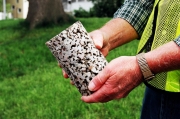- Error
{Re}habitat
Learn how adaptive reuse and upcycling can add hip design to your home, apartment, or yard with the Go Green channel's {Re}habitat series. Follow host Rachael Ranney as she shows you how to repurpose salvaged and found materials, adding fun and function to your space without breaking your budget.

HOK Architects has partnered with the U.S. Green Building Council to rebuild a Haitian orphanage. As early adopters of biomimicry principles, HOK Architects took inspiration from the native Kapok tree for the building’s design.
The lives of thousands of children were devastated by the magnitude 7.0 earthquake in Haiti on January 12, 2010, but thanks to a building initiative, many of these children will soon have a new place to call home.
Dealing with Discrepencies Between a Contracted Price and the Final Payment Application
Written by David A. Todd Fri Feb 10 2012Welcome to the On Site channel’s Construction Administration Column. What should you do when there is a discrepancy between the amount on a payment application and the amount that was contracted? Here David A. Todd, P.E., CPESC, gives his opinion.
Columnist David A. Todd, P.E., CPESC, has 37 years of experience in the architecture, engineering, and construction (AEC) industry and has performed much construction administration during that time. He will answer questions from our readers or from his own practice and will provide answers based on his understanding of the construction process and administration of the construction contract. The focus will be on the customary duties of the owner, contractor, and design professional as typically described in the contract documents.
Contractor to Contractor: In this first of a two-part series, contractor-turned-homebuilder Fernando Pages Ruiz introduces permeable pavement, which allows rain and snow to seep into the ground.
What is Pervious Pavement?
Pervious concrete came to the attention of the building community in the United States after Congress passed the Clean Water Act in 1987. With restrictions in the amount of storm water runoff permitted from roads, parking lots and other impermeable surfaces, some developers began to look for environmentally-friendly alternatives. They found it in an exotic, water-sucking concrete first tested in Florida about 30 years ago as a flood-control device. Engineers placed highly porous concrete paving in spots along Florida roadways frequently submerged by heavy downpours. The permeable surface provided a quick-drying roadway that didn’t stay flooded after the storm.
This is the fifth article in Buildipedia's series on U.S. Infrastructure, following the January 8, 2010 feature on dams, "It’s About Dam Time!"
The American Society of Civil Engineers (ASCE) assigned the United States’ DRINKING WATER infrastructure a grade of “D-” on their 2009 Report Card for America’s Infrastructure. Easy access to fresh water is a modern convenience that we might take for granted in our daily lives.
Carbon dioxide (CO2) is a by-product of human respiration. Each time we exhale, CO2 is released into the atmosphere around us. Currently, CO2 sensors can be used to automatically control ventilation systems in buildings equipped with Building Automation Systems (BAS). This is referred to as Demand Control Ventilation (DCV).
Bird control is a method of deterring birds from landing, roosting, and nesting in and around a building. In less extreme examples, birds in buildings can impede the productivity of workers and create additional building maintenance and cleaning challenges. In more extreme cases, they can damage capital equipment and create significant safety hazards. Fortunately, there is an entire industry in existence which offers various products and techniques for the control of birds, including bird spikes, bird shock tracks, netting, fragrances, wire arrays, and bundled wire stands, among others.
The Cost and Reliability of Electricity Service
The American Society of Civil Engineers (ASCE) assigned the United States’ ENERGY infrastructure a grade of “D+” on their 2009 Report Card for America’s Infrastructure. Electricity generation is the first of three installments on energy and covers nuclear, coal and natural gas, and hydro-electric power generating facilities. Electrical transmission and distribution will be covered in installments two and three as we follow the path of electricity from a power generating facility to your home or business. The goal is to provide an overview on how electrical power is delivered, including issues of current concern.
Technologies to monitor emergency lighting systems throughout buildings or campuses have increased in popularity across Australia over the last decade. During the last six years, emergency lighting monitoring systems have also become more popular in North America. The idea behind these systems is to connect all exit signs and emergency (battery-powered) lighting devices to a central computer station so that they can individually report their functional status when tested, offering significant time and cost benefits to facility managers.







